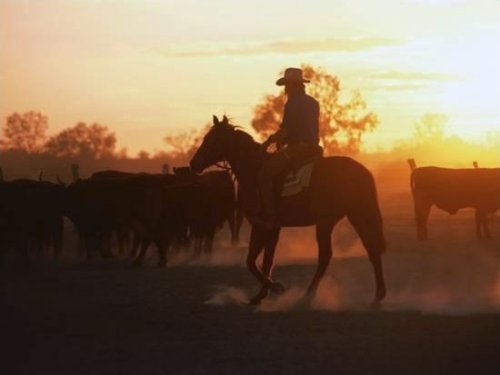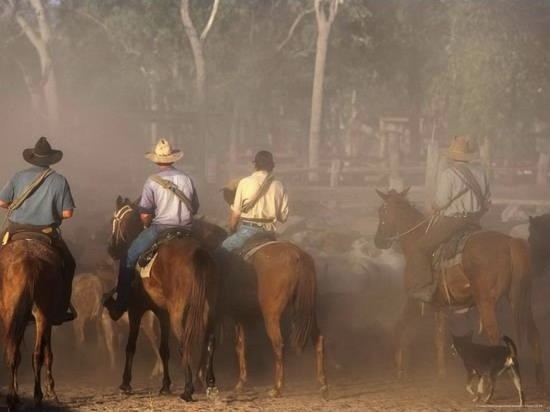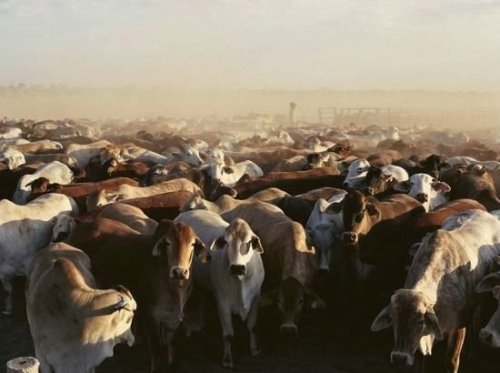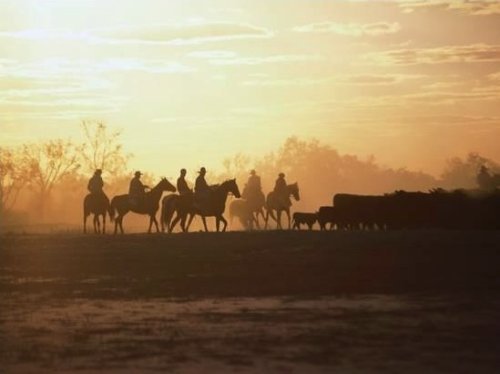Outback Stations - Australian Cattle Stations
"Cattle Stations In The Australian Outback"
Australian cattle stations (ranches) are often mentioned in the same breath as the Australian Outback.
For many people life in the Australian Outback is synonymous with living and working on an Outback cattle station.
I don't quite see it that way, but those Outback stations certainly are a big and important part of the Australian Outback.
This page is about the life, the work, and tourism on Outback cattle stations.

I highlighted the word big in the previous paragraph, because big they are... South and North America certainly produce a lot of cattle, too. (Brazil is the world's biggest exporter, before Australia at number two.) But if you look at the size of the individual stations you will find that the Australian cattle stations are by far the biggest in the world.
In fact, some Australian stations are bigger than some European countries... Take Anna Creek Station, well known as the biggest Australian cattle station: this station in the Outback of South Australia covers 6,000,000 acres, or 34,000 km2. (Belgium by comparison is just over 30,000 km2, and the biggest American ranch is about 6,000 km2.)
Why this huge size? Most of Australia's cattle stations are located in the north and the central regions of the Australian Outback. The Australian continent is so dry and the vegetation so sparse that a large amount of country is needed to support enough cattle to make a living.
This style of farming cattle is very different from what you might know, especially if you come from Europe. It is a very natural way. The animals are basically wild. They are usually born and grow up without any human contact. They are grass fed and rarely require any chemical treatment. Trust me, you can taste the difference between a steak from the Kimberley and one from a grain feed lot...
So how does an Australian cattle station operate?

A Group of Stockmen Mustering Cattle
The size and remoteness of these Australian cattle station defines the life style. Life is very isolated. Often the next human settlement is a day's drive away. Usually an Outback cattle station will have a little airstrip, and the mail plane will deliver mail and supplies on a regular basis.
Kids don't go to school. Their school is the "School Of The Air". In the past the teaching medium was the HF radio. Although today computers and satellites have replaced many of the radios, the title "School Of The Air" remains.
Any medical emergencies requires the help of the RFDS (Royal Flying Doctor Service).
The centre of the universe on any station is the "homestead", the main building where the manager lives. It is surrounded by sheds, machinery, accommodation for workers, vegetable gardens, yards, and, and, and...
But the most important aspect of life on a cattle station is that, from the moment you arrive, you are part of a close knit team. Everybody here relies heavily on each other, and everybody works hard from sunrise to sunset. At least for a large part of the year.
The north of Australia, where most of the big cattle stations are found, has a distinct wet and dry season. The dry season is the time for mustering, an incredibly work intensive period of very long days.

Brahman Cattle are herded into a pen
Because of the rugged nature of the Australian Outback a lot of the mustering is still done on horseback. Even though more and more stations are using helicopters and motor bikes to help with rounding up cattle, horses are absolutely essential to the operations of a large cattle station.
(This aspect attracts many travellers to the life and work on a cattle station. If you, too, have dreams of becoming a cowgirl or cowboy for one summer, here is some info on finding work on Australian cattle stations.)
A lot of the mustering activity will take place far away from the homestead. There is no time to travel back and forth every day (and who would want to on those rough tracks), so the whole workforce moves to camp where the mustering is happening. Weeks may be spent in these camps, spending the evenings at the fire and sleeping in swags on the ground.
It may sound romantic, but first and foremost it is about hard work, for men, women and horses alike. Work starts before sunrise and continues after sunset, and there is no such thing as weekends or public holidays...

Stockmen and Cattle, Outback South Australia
The mustering work is about more than gathering the cattle. The mob needs to be settled, walked to the yards and the weaners segregated from the cattle that is to be sold. There is branding to do, the vet needs to inspect the animals, they may be treated if necessary, and eventually they need to be loaded on trucks or returned to their million acre paddocks.
Horses might need shoeing and vehicles might need maintenance, and someone has to keep the people fed... I don't think many would disagree if I say the station cook is one of the most crucial employees to any Australian cattle station...
And that is just some of the work that needs doing. Work, work, work, that it was station life is about. (You might have heard about the evening dinner show Australian Outback Spectacular, which is basically a circus show romanticising the life on an Australian cattle station. It's nothing like that.)
Still, despite the hard, long days and the meagre pay, talk to station people, be it the managers, workers or the cook. It's a hard life, but they wouldn't have it any other way. And if you're game to find out why, you can...
Finding work on Australian Outback stations
A reader story about life on a cattle station:
A little about our place, Kilcowera Station
Find out more about the Australian Outback
Return from Australian Cattle Stations to the Outback Australia Travel Guide home page





